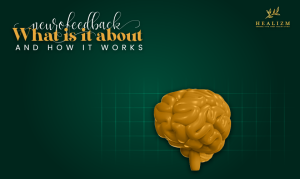
Neurofeedback is an effective method to help people overcome various neurological and psychological conditions. It involves training the brain to function more efficiently by monitoring and providing feedback on brain activity.
This blog post will explore what Neurofeedback is, how it works, and the benefits it can offer.
What is Neurofeedback?
Neurofeedback, also known as brain training or Neurotherapy is a non-invasive technique that uses sensors to monitor the brain’s electrical activity. This information is fed back to the patient in real-time using visual or auditory cues. The patient can use this feedback to learn how to regulate their brain activity, resulting in improved brain function.
How Does Neurofeedback (brain training or Neurotherapy) Work?
Neurofeedback works by training the brain to function more efficiently. It does this by providing the brain with feedback on its activity, which allows the brain to regulate its function. The feedback is provided through visual or auditory cues, such as a sound or a changing image on a computer screen.
During a neurofeedback session, the patient sits in a comfortable chair while sensors are placed on their scalp. These sensors monitor the brain’s electrical activity and send the information to a computer, which processes the data and generates feedback. The patient is then asked to perform a specific task, such as playing a game or watching a video, while the feedback is provided.
The patient can learn to regulate their brain activity by using the feedback to identify when their brain is producing the desired activity. For example, if the patient tries to reduce anxiety, the feedback might be a calming image or sound. If the patient’s brain produces more of this activity, they are rewarded with positive feedback. Over time, the patient can learn to produce this activity independently, resulting in improved brain function.
Types of Neurofeedback
There are several different types of neurofeedback. Each type of neurofeedback has its unique approach and specific benefits.
Surface Neurofeedback
This is the most common type of Neurofeedback and involves attaching sensors to the scalp to monitor and provide feedback on brain activity. Surface neurofeedback can be used to treat a wide range of conditions, including anxiety, depression, and attention deficit hyperactivity disorder (ADHD).
Microcurrent Neurofeedback (MCN)
MCN uses a low-level electrical current to stimulate the brain and help it regulate its activity. It is often used to treat anxiety, depression, and PTSD and other disorders.
Direct Neurofeedback
This Neurofeedback involves placing sensors on the scalp and using a small electrical current to stimulate specific brain regions. Direct Neurofeedback is often used to treat conditions such as traumatic brain injury and stroke.
The Othmer Method
This type of surface neurofeedback uses a protocol developed by Dr. Siegfried Othmer to target specific areas of the brain. Othmer’s neurofeedback method can be useful for treating conditions such as attention deficit hyperactivity disorder (ADHD), post-traumatic stress disorder (PTSD), and depression.
Hemoencephalographic (HEG) Neurofeedback
This type of neurofeedback measures changes in blood flow to the brain and uses this information to help individuals regulate their brain activity.
Z-score Neurofeedback
Z-score Neurofeedback compares an individual’s brain activity to a normative database of healthy brain activity using standardized Z-scores. This personalized approach helps identify and target specific areas of the brain that may not function optimally. Z-score Neurofeedback can alleviate symptoms associated with various conditions, including insomnia, anxiety, depression, and ADHD.
Functional Magnetic Resonance Imaging (fMRI)
This type of neurofeedback uses real-time fMRI scans to provide feedback to individuals about their brain activity.
Neurofeedback Treatment Protocols
Protocols refer to specific training plans or instructions to guide the neurofeedback treatment process. A protocol may include the following:
- Details about which areas of the brain to target.
- The specific types of brainwaves to train.
- The length and frequency of the training sessions.
Several different types of training can be used in neurofeedback therapy:
- SMR training: SMR stands for sensory motor rhythm, a specific type of brainwave associated with calm and relaxed states. SMR training involves teaching the brain to produce more SMR brainwaves.
- Alpha-theta training: Alpha and theta brainwaves are associated with deep relaxation and meditation. Alpha-theta training teaches the brain to shift from an alert, active state to a more relaxed, meditative state.
- Beta training: Beta brainwaves are associated with focused, alert states. Beta training involves teaching the brain to produce more beta brainwaves.
- Gamma training: Gamma brainwaves are associated with higher cognitive functions, such as problem-solving and decision-making.
Benefits of Neurofeedback
Neurofeedback treats various conditions, including anxiety, depression, ADHD, PTSD, and more. It can also improve cognitive functions, such as memory and attention.
One of the key benefits of Neurofeedback is that it is non-invasive and does not involve medication. It is also a safe and effective treatment option for people of all ages.
Getting Started with Neurofeedback
If you are interested in trying Neurofeedback, the first step is to find a provider in your area.
You will be asked to complete a questionnaire during your first appointment and undergo a quantitative electroencephalogram (QEEG) brain scan. This QEEG scan will help the provider understand your brain function and determine the best course of treatment for you.
The number of neurofeedback sessions you will need will depend on your individual needs and the condition you seek to treat. Generally, a course of treatment will involve multiple sessions over several weeks or months.
The cost of Neurofeedback can vary depending on the provider and the location.
The important thing to remember is that Neurofeedback is not a magic cure and may not work for everyone. However, it is a safe and effective treatment option that has helped many people improve their brain function.
How To Find QEEG Neurofeedback Near Me?
Here are a few things you should consider when finding a provider of QEEG neurofeedback you:
- Ask for referrals:
One of the best ways to find a qualified provider of QEEG neurofeedback is to ask for referrals from your healthcare provider, a trusted friend, or a family member. They may be able to recommend a provider in your area who has experience in using QEEG neurofeedback to treat your specific condition.
- Use online directories:
Several online directories can help you find providers of QEEG neurofeedback near you. Some popular directories include Psychology Today, GoodTherapy, and the International Society for Neurofeedback and Research (ISNR) directory. These directories allow you to search for providers by location and specialty.
- Contact professional associations:
Professional associations, such as the ISNR, can also provide you with a list of qualified providers in your area. These associations often have strict requirements for membership and can help you find a provider with the necessary training and expertise in QEEG neurofeedback.
- Check with your insurance provider:
If you have health insurance, your provider may cover some or all of the cost of QEEG neurofeedback. Contact your insurance company to find out if they cover this treatment and if there are any restrictions on which providers you can see.
When looking for a provider of QEEG neurofeedback, it is important to do your research and choose a qualified provider with experience in treating your specific condition. When selecting a provider, you should also consider factors such as location, cost, and availability.
QEEG: Risks, Benefits, and the Importance of Qualified Providers
While QEEG neurofeedback is generally a safe and effective treatment option, there have been rare cases where patients have reported negative experiences with this therapy method. Some individuals have claimed that QEEG scans have led to misdiagnosis, inappropriate treatment, or negative side effects that have impacted their quality of life.
It is important to understand that QEEG neurofeedback is a complex and highly specialized treatment requiring extensive training and experience. Patients must work with qualified providers skilled in using QEEG technology and interpreting the results of these scans.
Patients should also be aware of the potential risks and benefits of QEEG neurofeedback before starting treatment. While QEEG scans can provide valuable information about brain function and help identify underlying conditions contributing to symptoms, they may also uncover unexpected findings that require further evaluation.
In rare cases, QEEG neurofeedback may also cause negative side effects such as headaches, dizziness, or fatigue. These side effects are typically mild and temporary, but discussing any concerns or discomfort with your provider and following their recommendations for managing these symptoms is important.
Get Help With Healizm
If you are considering QEEG neurofeedback, you must work with a qualified provider who can help you understand the risks and benefits of this treatment and determine if it is appropriate for your specific needs.
At Healizm, our team of experienced and highly trained providers can guide you through QEEG neurofeedback and help you achieve optimal brain function and overall well-being.
